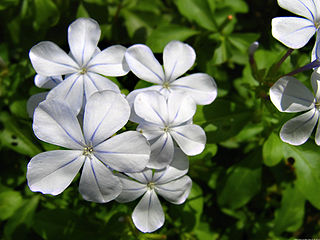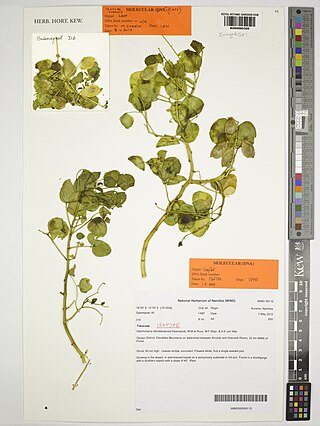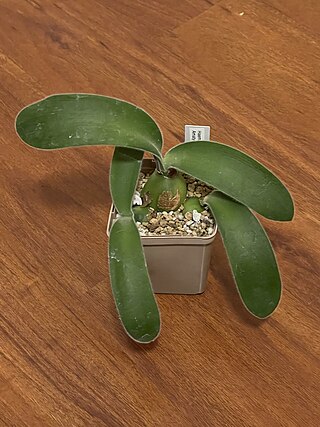
Plumbago is a genus of 23 species of flowering plants in the family Plumbaginaceae, native to warm temperate to tropical regions of the world. Common names include plumbago and leadwort.
Sericanthe is a genus of flowering plants in the family Rubiaceae. It is found in tropical and subtropical Africa. The genus was described by Elmar Robbrecht in 1978 based on the species in Neorosea, except for the type species, Neorosea jasminiflora, which went to Tricalysia. Bacterial leaf nodules are found in most of the species and the endophytic bacteria have been identified as Burkholderia.
Abraham Erasmus van Wyk, also known as Braam van Wyk is a South African plant taxonomist. He has been responsible for the training of a significant percentage of the active plant taxonomists in South Africa and has also produced the first electronic application (app) for the identification of trees in southern Africa.

Stirtonanthus is a South African genus of flowering plants in the family Fabaceae. It includes three species of shrubs native to the Cape Provinces of South Africa. They grow in fynbos at medium to high elevations. Each species is highly localized. It belongs to subfamily Faboideae.

Xiphotheca is a genus of flowering plants in the legume family, Fabaceae. It includes 10 species of shrubs endemic to the Cape Provinces of South Africa. They grow in fynbos, generally at medium or low elevations, and often species have highly localised ranges. The genus belongs to the subfamily Faboideae. The name of the genus is a compound of Ancient Greek ξίφος (ksíphos), which means "sword", and θήκη (thēkē) which can mean "box" or "sheath"—a reference to the shape of the legume pods. Members of this genus can be distinguished by:
"(1) the presence of bracteoles in most species; (2) the fusion of the bracts with the base of the pedicel; (3) the laterally compressed pods; and (4) the accumulation of anabasine as a major alkaloid."

Tulbaghia siebertii is a species of flowering plant native to South Africa. If was described in 2007 from the Leolo Mountains of Limpopo Province as Prototulbaghia siebertii.
Listia is a genus of flowering plants in the family Fabaceae and the tribe Crotalarieae. Members of this genus are mainly found in southern Africa but some species can be found in central Africa. It was recently segregated from the genus Lotononis. Unlike other members of the Crotalarieae, members of the genus Listia have lupinoid root nodules.
Wiborgiella is a genus of flowering plants in the family Fabaceae. It belongs to the subfamily Faboideae.

Genisteae is a tribe of trees, shrubs and herbaceous plants in the subfamily Faboideae of the family Fabaceae. It includes a number of well-known plants including broom, lupine (lupin), gorse and laburnum.

Oberholzeria is a monotypic genus of flowering plants in the legume family, Fabaceae. It only contains one known species, Oberholzeria etendekaensis which is endemic to Namibia. It belongs to the subfamily Faboideae, though its tribal affiliation is unclear.

Curio is a genus of flowering plant in the family Asteraceae. Plants in the genus are evergreen succulents with long, striated leaves and discoid flower heads lacking ray florets.
Polygala sekhukhuniensis is a species of flowering plant in the milkwort family (Polygalaceae). It is endemic to South Africa.
Trisetopsis is a genus of flowering plants belonging to the family Poaceae.
Cannaboides is a genus of flowering plants belonging to the family Apiaceae.
Diane Mary Bridson is a British botanist.
Pseudocannaboides is a genus of flowering plants belonging to the family Apiaceae.
Dewinteria is a monotypic genus of flowering plants belonging to the family Pedaliaceae. The only species is Dewinteria petrophila.
Tana bojeriana is a species of flowering plant in the family Apiaceae, endemic to Madagascar. It is the only species in the monotypic genus Tana. The genus was first described in 1999, and the species was first described by John Gilbert Baker in 1890 as Peucedanum bojerianum.
Andriana is a genus of flowering plant in the family Apiaceae, endemic to Madagascar. The genus was first described in 1999.

Haemanthus pauculifolius is a species of Haemanthus native to Mpumalanga province of South Africa and Eswatini first described in 1993.








